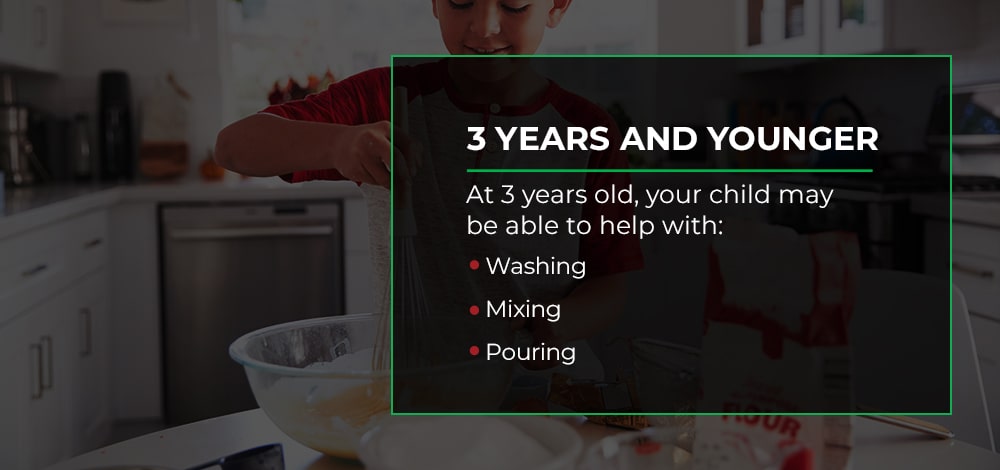How to Teach Your Kids to Cook
As a parent, you know the struggle of keeping your kids entertained while also trying to get dinner on the table. While combining the two tasks together seems like a challenge, these tips for teaching kids to cook make the process fun and enjoyable for everyone.
Benefits of Teaching Kids to Cook
While learning how to teach kids to cook takes a lot of patience, the benefits truly show what an enriching experience cooking together is for your child.
1. Provides Fun for the Whole Family
As children get older, it can become hard to elicit enthusiasm for activities outside of their comfort zone. Spending time together in the kitchen prompts a sense of unity and trust. It gives your child something to look forward to and creates a space where they feel safe and close to you, while making memories that will last a lifetime.
2. Teaches a Life-Long Skill
Along with being an important skill to have going into adulthood, cooking requires skills beyond the obvious benefit of being able to feed yourself. It’s a pastime that requires teamwork, communication and an open mind. Cooking with your child will teach them kitchen safety and plant a seed of respect for you and all the work you put into making meals for the family. Your child will also use the recipes they learn for the rest of their lives.
3. Encourages Curiosity and Exploring
Adding in fun activities to teach kids about cooking will encourage them to enjoy the process and embrace their culinary creativity as they learn and grow. The explorative nature of learning to cook will empower your kids to try new foods and put their skills to the test in a safe environment. As they mature they will progress from decorating cupcakes and cookies to more advanced skills like chopping vegetables and cooking meat.
How to Teach Kids to Cook — By Age
Whether you’re a new parent or have a few little ones running around, every mom and dad is hyper-aware that childhood development happens incredibly fast. Kids often make huge strides in bursts of growth, which means they are capable of learning new skills in the kitchen at every age.

3 Years and Younger
Teaching your children to cook at such a young age helps them hone fine motor skills, develop sensory awareness and learn basic kitchen dos and don’ts. At 3 years old, your child may be able to help with:
- Washing: In their toddler stages, children who want to participate in the kitchen are capable of washing their hands and produce. You can use a child-safe step ladder or seat that brings them to sink height so they can practice washing fruits and vegetables.
- Mixing: While you may not want to put your dinner at risk, your toddler can still practice mixing with spoons, spatulas, whisks and their hands. You can give them a bowl with a small portion of water and flour, water and food coloring or chopped fruit to mix together.
- Pouring: To work on hand-eye coordination, try giving your child two small measuring cups or a cup and bowl to practice pouring. Over time they will be able to confidently transfer ingredients, as well as clean up their messes when spills inevitably happen.
Consider trying these cooking methods with your younger child:
- Chocolate-covered snacks: Dipping with fruits and other snacks in chocolate is a perfect introductory cooking lesson. While kids may not cover every piece perfectly, the goal is to help them develop these skills.
- Pitchers of drinks: Whether your family likes to drink lemonade or powdered, fruit-flavored drinks, letting your toddler add the ingredients to the water and mix it up is a great way to involve them in the process.
- Preparing fruit: You can also teach your child to prepare certain fruits, like peeling bananas and clementines or picking grapes off the stems.
4-6 Years Old
By 4-6 years of age, your child is ready to put new skills to the test. They are eager to learn and want to feel supported going out of their comfort zone, so they might be ready for activities like:
- Cutting: A quick internet search will show you examples of child-safe knives that are perfect for when your kids are helping out in the kitchen. Giving them soft foods, like bananas, strawberries and sausage links will ensure that they will complete their tasks without you worrying about their safety.
- Layering: As you are introducing your children to cooking, layering is an easy and useful skill that will keep them involved while also helping you. Sandwiches, salads, non-bake desserts and casseroles all require layering, which means knowing which ingredients work better on the top, middle and bottom of a dish.
Try these kid-friendly recipes with your 4-6-year-old:
- Sandwiches: Sandwiches allow children to be creative and tidy. You can use any number of ingredients to mix and match different sandwiches for every day of the week.
- Salads: Fruit, macaroni or traditional — salads are a food that everyone loves. Your child can practice chopping soft items with a child-safe knife and mix the ingredients together on their own.
7-10 Years Old
By this age, your kids should have all the confidence to try new things and use new tools and utensils to create fun and tasty dishes. For example, they might try:
- Cooking on the stove: While your child may not be ready for full bakes or complicated recipes, they are capable of making basic dishes with heat. Pancakes and grilled cheese are complete meals that teach your child how to use a spatula and operate the stove. Be sure to offer supervision whenever your child is cooking with heat.
- Breading chicken or veggies: Your child is now capable of dipping properly, handling multiple ingredients at one time and transferring food from one area to another. All of these skills can be applied to breading chicken, eggplant and snacks like jalapeño or cauliflower poppers.
- Measuring and proportions: At this stage, children understand how to read instructions and carry them out. By allowing them to measure ingredients, you are putting their math and reading skills to the test. When you let them fill those measurements by themselves, you are encouraging independent growth.
Kids aged 7-10 should be able to make the following dishes:
- Breakfast: Many breakfast dishes are simple, which is perfect for young chefs. Scrambled eggs with toast are simple to make, and kids can even heat up breakfast sausages on the stove with adult supervision to make sure the meat is cooked through.
- Quesadillas: This lovable food allows your child to add their own preferred ingredients while providing the challenge of cooking it on the stove and flipping it without losing all the filling.
- Baking: Ages 7-10 is the perfect time to get kids started with baking. Since the oven does most of the cooking, you can rest assured that your child will be safe measuring and mixing ingredients like flour, sugar and eggs to create tasty desserts. Plus, decorating with frosting and sprinkles is the best part!
Cook With the People and Ingredients You Love
After 40 years of crafting fine fresh Italian sausage, Premio Foods knows how to make every family dinner a moment to remember. We understand the importance of nourishing your loved ones with quality ingredients, which is why all of our sausages are 100% meat and absolutely zero fillers.
Find our superior sausages at a store near you or start shopping our products online at Premio Foods today!

